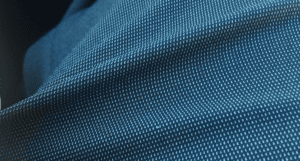The Best Way to Wash Polyester Clothes
-
 By
Sophia Grant
By
Sophia Grant

Synthetic fibers have become more and more popular over the past several years. Unlike natural materials such as cotton, these fibers are man-made through various chemical processes.
This makes them much more durable than standard fabrics. Not only that but they’re also easier to dye, which makes them a popular choice for clothing.
Table of Contents
ToggleWhat Is Polyester Fabric?
Polyester is a common type of synthetic fabric. Invented in the early 1940s by a group of scientists, the material is inexpensive as it is derived from plastic.

More specifically, the plastic is heated, melted, and turned into fibers by a large machine; the resulting fibers are then stretched and knitted into a synthetic fabric.
In some cases, it is incorporated with other materials such as cotton or spandex.
Pros of Polyester Garments
As with all synthetic fabrics, polyester is strong and resilient. Often used for clothing, it is flexible, easy to clean, and resistant to wrinkles.
Does polyester shrink? Not usually.
When washed, it also dries quickly, which fends off contaminants from developing. Another great thing about polyester is that it’s naturally moisture-wicking, meaning that it is able to draw moisture away from the skin.
Cons of Polyester Garments

Having said that, there are a few disadvantages to the material. For instance, it is not nearly as breathable as say, cotton.
Depending on how they’re made (some are treated with certain chemicals), they might also be flammable.
What is Polyester Typically Used For?
Polyester is used in all kinds of clothing. However, it is most commonly seen in activewear such as leggings and sports bras. Why?
The fabric directly pulls sweat away from the skin, meaning that you’ll stay dry during your workout.
How to Wash Polyester Items
Polyester might be more durable than some fabrics, however, it can still wear down in the wash. Given how pricey some activewear can be, it’s important that you take proper care of the material.
Machine Washing Instructions for Polyester Fabrics
Polyester is generally machine washable. With that said, you should always read the care labels on the individual garments before putting them in the washer; this is especially true if you’re washing the items for the first time.
For instance, some polyester clothes may contain other fabrics that require special care (e.g. dry cleaning).
Step 1: Turn Them Inside Out
Turn your polyester clothing inside out before putting them in the washer. This has to do with the way the polyester fibers are woven together, which makes it more prone to snagging.
By turning them inside out, you’ll be able to prevent them from being damaged by your other laundry.
Step 2: Add ACTIVE Detergent

Add one to two scoops of ACTIVE detergent (depending on the size of the load) into the washing machine and run a gentle cycle with warm water.
Step 3: Let Them Air Dry

Take your polyester clothes out of the washer as soon as the cycle is done and let them air dry.
Supply:
- ACTIVE Detergent
- Laundry bag
Cold water can also be used to wash polyester fabrics, however, it will not be as effective at removing stains—especially grease and oil.
ACTIVE Laundry Detergent
Specifically designed to deep clean synthetic fabrics like polyester.

15% Off Your Order on Amazon
×Click below to reveal the 15% off coupon for your entire ACTIVE purchase on Amazon.com
Can You Put Polyester Clothing Into the Dryer?
Ideally, you want to let the items air dry – that will extend the life of the polyester material. In a pinch, however, you can use the dryer.
Just be sure to use the lowest setting; the polyester fabric might be heat resistant but it can still get damaged over time.
How to Wash Polyester Garments By Hand
Polyester fabrics can also be washed by hand. In fact, it’s the gentlest option.
Supplies:
- ACTIVE Detergent
- Water
- Clean towel
Step 1:
To start, fill a basin or sink with warm water. Pour in a small amount of ACTIVE detergent and stir to create a soapy solution.

Step 2:
Place the polyester items into the mixture, making sure they’re fully submerged in the liquid.
Let them sit and soak for at least 15 minutes before washing.

Step 3:
Once they’ve been soaked, wash the items gently by rubbing the polyester material against itself.
Avoid twisting motions as that can deform your clothing.

Step 4:
Rinse the detergent out with clean water afterwards. Continue doing this until the water turns clear.

Step 5:
Press them against a dry towel to squeeze out extra water, then allow them to air dry.

How to Get Rid of Stains on Polyester Clothes
Polyester, like most fabrics, is prone to discoloration and stains. Fortunately, there are several things that you can do to get them looking like new again.
Using Baking Soda
Baking soda is more than just a baking ingredient—it can also be used for stain removal.
Supplies:
- Baking soda
- Small bowl
- Water
- Soft bristle brush

Step 1:
In a small bowl, mix some baking soda with cold or warm water (one part baking soda to two parts warm water) to create a thin paste.

Step 2:
Using a soft bristle brush (e.g. old toothbrush), apply some of the paste onto the stained fabric. For the best results, brush it onto both sides.

Step 3:
Let the fabric sit for at least one hour – that will give the baking soda ample time to set into the fibers.
Once the stain is gone, you can launder the item as normal with ACTIVE Detergent.
Using White Vinegar
White vinegar can also be added to your polyester clothes to remove stains.
Supplies:
- White vinegar
- Warm water
Step 1:
In a large container or sink, create a solution by mixing 1/3 cup vinegar to 2/3 cup warm water.

Step 2:
Soak the garments in the mixture for at least one hour (possibly longer if it’s a stubborn spot) before washing them as normal.

You can also remove stains with apple cider vinegar.
Using Rubbing Alcohol
Rubbing alcohol is another one of those household products that can be used for stains—especially ink spots.
Supplies:
- Rubbing alcohol
- Sponge

Step 1:
Dampen a sponge with rubbing alcohol and use it to blot the problem area. Continue to blot the spot until the liquid is absorbed completely.

Step 2:
Alternatively, you can spray rubbing alcohol onto the stain. Make sure the entire area is saturated.
Prevent Your Polyester Clothing From Stinking & Remove Odors
It’s not uncommon for polyester clothing to develop odors as they’re less breathable than other fabrics. Don’t worry, though, there are a few things that you can do when washing polyester to prevent them from smelling icky.
Air Out Your Polyester Garments
One of the best ways to prevent odors is to air out your clothes. Instead of keeping them in a bag after a workout, hang them up; this will help to prevent the growth of odor-causing residues.
Don’t Leave the Items in the Washing Machine
Have you ever taken your clothes out of the washer just to realize that they smell musty? This can happen if you leave them inside the machine for too long after washing.

This happens because contaminants love and thrive in dark, wet spaces, such as the inside of your washing machine. That’s why it’s so important to take your clothes out as soon as possible after washing.
Skip the Fabric Softener
As a general rule, you never want to use fabric softener on polyester clothing. It will coat the outer surface with a wax-like substance that will prevent sweat and oils from being washed away properly.
That’s not all, it’ll also hinder its ability to pull moisture from the skin.
SAVE
15% off
Your Next ACTIVE
Purchase on Amazon
15% Off Your Order on Amazon
×Click below to reveal the 15% off coupon for your entire ACTIVE purchase on Amazon.com
Limited Time Offer






Comment (1)
Is there any potential problems if you wash 100% polyester garment with 100% cotton garment? Of course, following the “like color” rule. Thanks in advance for your comment, TD